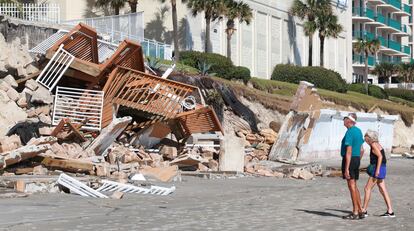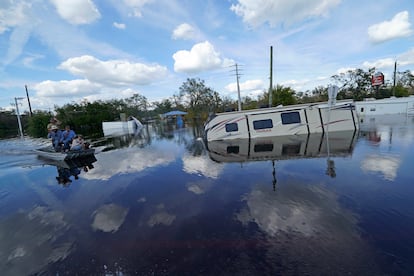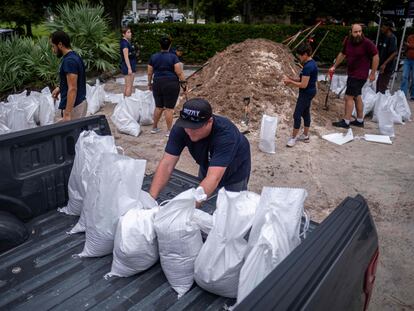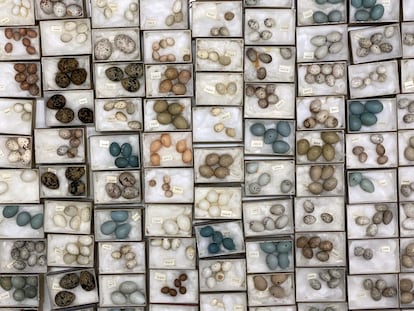The aftermath of Hurricane Ian’s deadly passage across Florida
EL PAÍS follows the destructive trail of the storm, which killed at least 100 people in the state


It took Hurricane Ian around 24 hours to cover the 450 kilometers (280 miles) that separate Key West, where it made landfall last Wednesday, and St. Augustine, the last municipality in Florida where it vented its fury. “That damned storm took its time,” said Martha, a nurse by profession, on Monday outside the house where she spent three days in calf-deep water and unable to go out in Daytona beach, a vacation destination an hour south of St. Augustine. On Wednesday, the storm uprooted a huge oak tree in the yard. By Friday, the National Guard was finally able to get into the area. And on Saturday, Martha was passed from one shelter to another as she sought help.
Daytona Beach is in the far northeast of Florida, and it was the penultimate stop of Ian’s destructive passage across the state, a journey that would take five hours by car. The fearsome hurricane arrived at the end of its own trip in the form of a tropical storm, its raging winds having died down, but it had one kick left in its tail: the same phenomenon, which is attributable to climate change, that had caused it to generate such power before reaching the US coast due to the heat of the water in the Gulf of Mexico, also caused it to regather its strength in the Atlantic before it smashed into the Carolinas at hurricane force again, leaving four people dead in its wake in North Carolina. According to calculations made on Monday night, Ian has been responsible for at least 100 fatalities across Florida.
As well as knocking out power in Daytona Beach, Ian also took down the robust wall of a beachfront hotel that has drawn onlookers to the site to witness the destructive force of the hurricane. In St. Augustine, the winds blew the sea inward, flooding a large part of the historic district. And in the case of this city of over 14,000 inhabitants in St. John’s County, it is not an adjective designed to draw attention to the relative youth of the United States: it is the oldest continuously inhabited European-established settlement in the contiguous US, founded by Spanish explorers in 1565. Sylvia, a Cuban who works for a company in front of the Castillo de San Marcos that offers visitors tours, on Monday pointed out where the water had reached a height of 80cm in Ian’s wake.
Water, rather than winds, has become Florida’s biggest problem in the calm after the storm. In Kissimmee, in the center of the state, the rising lake swept away Jay and Chris’ airboat cruising business and in St. Cloud, 150 families were forced from their homes on Sunday in a residential area where they believed the worst was over. Michael O’Connor certainly didn’t expect to spend Sunday night “in an Airbnb with my five kids,” but he had little choice.

O’Connor’s problem has a name: compound flooding. This is the term used to describe what occurs when overflows caused by a hurricane’s storm surge prevent rivers from flowing into the sea because they are at maximum capacity due to heavy volumes of rain, another phenomenon caused by climate change, according to a study published in Nature earlier this year.
The after-effects of Ian are also being felt in Orlando: residents have been asked not to use more tap water than is strictly necessary and there are hotels in some areas of the city where whole floors remain closed off. Power was restored to some parts of Orlando as late as Sunday and according to PowerOutage.us there are still 461,000 people without electricity in Florida, where the number peaked at 2.6 million in the immediate aftermath. However, the extraordinary economic machinery of Disney World saw the theme park open for business again last Friday.
The journey through the devastation, which also included Cape Canaveral, where NASA took measures to minimize the damage, began in the barrier islands off the southwest coast of Florida, where the hurricane’s impact was most keenly felt. Fort Myers Beach, where road access remains restricted, and the islands of Sanibel and Captiva, which are still cut off from the mainland except by air after Ian cut their road link to the peninsula in half, accounted for the majority of fatalities.
More than half of all the confirmed dead, 54 people in total at the latest count, lost their lives in Lee County, on the islands, in Fort Myers, Naples, Cape Coral and Bonita Beach. Search teams in the area are still combing houses door to door for survivors while the authorities are facing accusations of having taken a day too long to issue a mandatory evacuation order. Florida Governor Ron DeSantis shrugged off those accusations on Sunday, stating that sooner or later many residents in the southwest of the state would have decided to remain at home and ride the storm out.
Some of those affected by Ian stated that they were persuaded to remain at home by a mixture of confusing information (meteorologists had predicted Ian would make landfall further north, in the Tampa area) and the type of reckless confidence that comes from being well-versed in natural disasters. Many others were wealthy residents for who Florida is a second home or people who were able to spend a few days with friends or family in cities like Chicago or New York.

After devastating communities where the media focused its attention over the course of the weekend, Ian made its way to the northeast in the direction of Daytona Beach and St. Augustine, leaving 24 people dead in Charlotte County and four in Sarasota, where entire neighborhoods were flooded n towns like North Port and Arcadia, where some residents still have to reach their homes by canoe while attempting not to come across alligators, whose natural routines have also been thrown out of kilter by the hurricane. It is not a good time to become ill in this corner of Florida. There are hospitals in the area that are still not fully functioning due to power outages and a lack of potable water, and may patients are being diverted to other parts of the state.
Tu suscripción se está usando en otro dispositivo
¿Quieres añadir otro usuario a tu suscripción?
Si continúas leyendo en este dispositivo, no se podrá leer en el otro.
FlechaTu suscripción se está usando en otro dispositivo y solo puedes acceder a EL PAÍS desde un dispositivo a la vez.
Si quieres compartir tu cuenta, cambia tu suscripción a la modalidad Premium, así podrás añadir otro usuario. Cada uno accederá con su propia cuenta de email, lo que os permitirá personalizar vuestra experiencia en EL PAÍS.
¿Tienes una suscripción de empresa? Accede aquí para contratar más cuentas.
En el caso de no saber quién está usando tu cuenta, te recomendamos cambiar tu contraseña aquí.
Si decides continuar compartiendo tu cuenta, este mensaje se mostrará en tu dispositivo y en el de la otra persona que está usando tu cuenta de forma indefinida, afectando a tu experiencia de lectura. Puedes consultar aquí los términos y condiciones de la suscripción digital.
More information
Archived In
Últimas noticias
Most viewed
- Alain Aspect, Nobel laureate in physics: ‘Einstein was so smart that he would have had to recognize quantum entanglement’
- Mexico’s missing people crisis casts a shadow over World Cup venue
- Why oil has been at the center of Venezuela-US conflicts for decades
- Trump clarifies who is ultimately in charge in Venezuela: ‘Me’
- Mexico seeks to shore up its defenses following US incursion in Venezuela










































